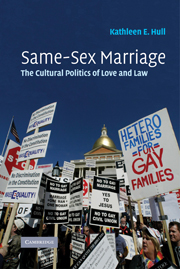Book contents
- Frontmatter
- Contents
- List of tables
- Preface
- Same-sex marriage timeline
- 1 Marriage, culture and law
- 2 Doing the rite thing: cultural practices of commitment
- 3 How do I love thee? Questioning the marriage model
- 4 Making it legal: marriage, law and legality
- 5 Sin or civil right? Debating marriage in the states
- 6 Conclusion: marriage and beyond
- Epilogue
- Appendix A Interview guides
- Appendix B Sample characteristics
- Appendix C Study participants
- Notes
- Court cases
- References
- Index
4 - Making it legal: marriage, law and legality
Published online by Cambridge University Press: 05 June 2012
- Frontmatter
- Contents
- List of tables
- Preface
- Same-sex marriage timeline
- 1 Marriage, culture and law
- 2 Doing the rite thing: cultural practices of commitment
- 3 How do I love thee? Questioning the marriage model
- 4 Making it legal: marriage, law and legality
- 5 Sin or civil right? Debating marriage in the states
- 6 Conclusion: marriage and beyond
- Epilogue
- Appendix A Interview guides
- Appendix B Sample characteristics
- Appendix C Study participants
- Notes
- Court cases
- References
- Index
Summary
Law is the quintessential form of the symbolic power of naming that creates the things named, and creates social groups in particular. It confers upon the reality which arises out of its classificatory operations the maximum permanence that any social entity has the power to confer upon another, the permanence which we attribute to objects.
— Pierre Bourdieu (1987)The previous two chapters examined the range of cultural practices used by same-sex couples to enact their intimate commitments, and found considerable variation among couples in their adoption of marriage as a cultural model of relationship. Some couples embraced the marriage model wholeheartedly, others were more hesitant or selective in their use of marriage-related terms and practices, and a few sought to distance their own relationships from marriage. This chapter examines same-sex couples' views and attitudes regarding legal recognition of their relationships, and finds similar variation. Although the people in this study shared broad agreement on the desirability of legal recognition for same-sex couples, they varied in their views about the form such recognition should take, the reasons legal recognition is important and the priority that should be given to legal marriage as a gay rights issue.
My interviews with the couples in this study reveal that the law represents a significant cultural force and resource for some but not all people in same-sex relationships. Law and culture are closely intertwined in the way many gays and lesbians perceive and enact marriage in their own lives.
- Type
- Chapter
- Information
- Same-Sex MarriageThe Cultural Politics of Love and Law, pp. 116 - 151Publisher: Cambridge University PressPrint publication year: 2006



